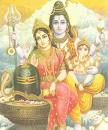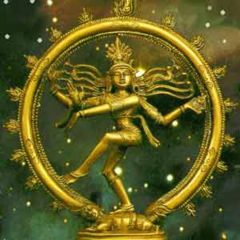Hinduism
 From Conservapedia
From Conservapedia 
Hinduism is the third largest religion in the world and is the oldest among major religions.[1] Historians believe that it originated more than 5000 years ago.[2] Hinduism is the first Dharmic religion. It is often referred to as "the religion of India;" about 800 million of the world's billion Hindus live in India, so about 80 percent of Hindus are Indians.[3] According to a recent American survey, Hindus are the best educated and among the richest religious groups in the United States.[4]

Hindus believe in reincarnation and eventual communion with Brahman (God) as well as respect for all life forms. Their holy writings are known as the Vedas. Hindus outline the four goals of various humans (purusharthas) as: dharma (righteousness), artha (material success), kama (love/pleasure), and moksha (release from reincarnation/reunification with Brahman); above all four of these, in certain Hindu schools, is the goal of pure Love of God.
Contents
- 1 Definition by law
- 2 Believer?
- 3 Issues
- 3.1 Sati
- 3.2 Caste system
- 4 Hinduism and abortion
- 5 See also
- 6 References
- 7 Further reading
- 8 References
- 9 External links
Definition by law[edit]
In 1966, the Supreme Court of India defined what Hinduism is for legal purposes:
1. Belief in the authority of the Vedas (an ancient collection of hymns to the gods, written in Sanskrit). The oldest collection of hymns in the Vedas is the Rig Veda, which was written between 1800 and 1300 B.C. The greatest Veda hymn is the “Bhagavat Gita,” a section in the Mahabharata concerning life’s never-ending spiritual journey towards perfection. Bhagavat Geeta is rendered as a dialogue between Shri Krishna (incarnation of Vishnu) and Arjuna (the great archer) in the middle of the battlefield.
2. Spirit of tolerance and willingness to understand and respect an opponent’s view.
3. Belief in world rhythms: long periods of creation, maintenance and dissolution follow each other in endless succession.
4. Belief in reincarnation (rebirth) and preexistence.
5. Belief that there are many ways to salvation.
6. Unlike most other religions, Hinduism is not defined by a specific set of philosophical concepts.
7. Belief in one god. Contrary to popular belief, Hinduism is not a polytheistic religion. The Vedas, the primary Hindu holy scriptures states that there is only one God but can manifest in many forms. This is the reason why there are many deities. A common example used to explain this is that an individual can be called different names depending on the relationship has with another. A man can be a son to his parents, a nephew to his uncle, a father to his son, and a husband to his wife all at the same time. None of these different relationships suggest multiple people but rather different aspects of one person. The same is applied to God in Hinduism, which has no form and is infinite. Hindus may call God, Paratman (Supreme Soul), Brahmana (Eternal Spirit), or Ishvara (Supreme Lord). Deities have various names but represent aspects of God that manifest in the world. For example, Agni (fire, Divine spark), Vayu (wind, or breath which could mean life force), Indra (in mythology king of gods but also refers to the senses such as vision, hearing, touch, taste), and Lakshmi (fortune).
8. Secular multiplicity and accommodating flexibility in spiritual practices.
Relations between Hinduism and Christianity have also been shaped by unequal balances of political power and cultural influence. Although communities of Christians have lived in South India since the middle of the 1st millennium, the great expansion of Indian Christianity followed the efforts of missionaries working under the protection of the British colonial government.[5]
Some state governments such as Gujrat, Madhya Pradesh have passed anti-conversion laws, attempting to prevent Hindus from being forced or coerced into converting to other religions such as Islam and Christianity.[6]
For more on Hinduism, see World History Lecture Three.
Believer?[edit]
In Hinduism, according to one classification, believers are categorized into four distinct categories, according to their beliefs.
- Advaita Astika: Believer of God & Believer of Scripture
- Advaita Nastika: Believer of God & Non-believer of Scripture
- Dvaita Astika: Non-believer of God & Believer of Scripture
- Dvaita Nastika: Non-believer of God & Non-believer of Scripture
Issues[edit]
Sati[edit]
Sati is an old practice, it's practice is forbidden by the Hindu scriptures in Kali Yuga, the present age.[7] In this practice the widow was immolated alive on her husband's funeral pyre, although the practice was made as per the agreement of the widow. However, during the Islamic invasion of Indian subcontinent, this practice revived, as rapes, abduction were normally carried out by Islamic invaders.[8][9] To this day, the practice remains illegal in India.
Caste system[edit]
Caste system is neither unique to Indian society or limited, it has been prevalent in many parts of world, such as "Al-Akhdam" of Yemen, "Songbun" of North Korea, and others.
It's apart from religion, but closer to practical life. The book Manusmriti texts contains varnas based on profession. Traditionally Hindu society is divided into four castes:
- Brahmin (the highest class)
- Kshatriya (the warrior or ruling class)
- Vaishya (merchants)
- Shudra (unskilled laborers and servants)
Originally, caste was determined by profession, and could be changed by changing career.[10] With the start of British colonization, caste system established by British and caste became defined by birth.[11]
Shudras were the lowest caste and were denied of many rights in past. Apart from these four main castes, there was a new addition in the modern distortion of the caste system, as the lowest caste called the Dalit (Untouchables).[12] Historically these dalits are the victims of discrimination by higher castes, to this day.[13][14] Despite this, there has been large amount appreciation towards the caste system, especially because it differed from the racial system such as casta of Spain, admirers includes the notable personalities such as Annie Besant, P.D. Ouspensky, Pandurang Shastri Athavale and Sarvepalli Radhakrishnan. Friedrich Nietzsche is noted to have said "Close the Bible and open the Manu Smriti."[15]
Hinduism and abortion[edit]
The teachings of Hinduism exact non-violence. Hinduism is generally opposed to abortion except if the life of the mother is at risk.[16]
See also[edit]
| ||||||||
References[edit]
- ↑ The largest being Christianity, Islam, Secular/Nonreligious/Agnostic/Atheist, and Hinduism, in that order [1]
- ↑ Origin of Hinduism (About.com)
- ↑ Census of India, religion data, brief analysis (PDF); "At the national level, of 1028 million population, 828 million (80.5 percent) have returned their religion as Hindus followed by 138 million (13.4 percent) as Muslims and 24 millions (2.3 percent) Christians. 19 million (1.9 percent) persons follow Sikh religion; 8 million (0.8 percent) are Buddhists and 4.2 million (0.4 percent) are Jains as per the 2001 Census. In addition to these, 6.6 million belong to ‘Other Religions and Persuasions’ including tribal religions which are not part of the six main religions stated above. About seven lakh (or 0.7 million) persons have not stated their religion."
- ↑ Hanerjee, Neela, Americans Change Faiths at Rising Rate, Report Finds, New York Times, 25th February, 2008.
- ↑ Hinduism and Christianity Encyclopædia Britannica.
- ↑ India: International Religious Freedom Report 2003 (U.S. Department of State)
- ↑ Heart of Hinduism Other Social Issues. Retrieved on 2013-09-13.
- ↑ "Encyclopaedia Indica: India, Pakistan, Bangladesh" by S. Shashi, p. 115
- ↑ "The Danger of Gender: Caste, Class and Gender in Contemporary Indian Women's Writing" by Clara Nubile, p.9
- ↑ The Caste System
- ↑ de Zwart, Frank (July 2000). "The Logic of Affirmative Action: Caste, Class and Quotas in India". Acta Sociologica 43 (3): 235–249.
- ↑ The caste system BBC
- ↑ Dalits face discrimination in southern Tamil Nadu All India Christian Council
- ↑ India: ‘Hidden Apartheid’ of Discrimination Against Dalits Human Rights Watch
- ↑ Friedrich Nietzsche, The Will to Power, vol. 1.
- ↑ https://www.bbc.co.uk/religion/religions/hinduism/hinduethics/abortion_1.shtml
Further reading[edit]
- Johnson, W. J. A Dictionary of Hinduism (2009) excerpt and text search
- Knott, Kim. Hinduism: A Very Short Introduction (2000) online edition
- Shattuck, Cybelle. Hinduism (1999) online edition
- Sullivan, Bruce M. Historical Dictionary of Hinduism (1997)
- Werner, Karel. A Popular Dictionary of Hinduism (1997) excerpt and text search
- Zaehner, R. C. Hinduism (1966) online edition
References[edit]
External links[edit]
- Hindu Religion
- The Caste System
- Parmatma
Categories: [Hinduism] [Dharmic Religions] [Yoga] [Meditation] [India] [Indian History]
↧ Download as ZWI file | Last modified: 03/25/2023 01:12:16 | 252 views
☰ Source: https://www.conservapedia.com/Hinduism | License: CC BY-SA 3.0
 ZWI signed:
ZWI signed: KSF
KSF